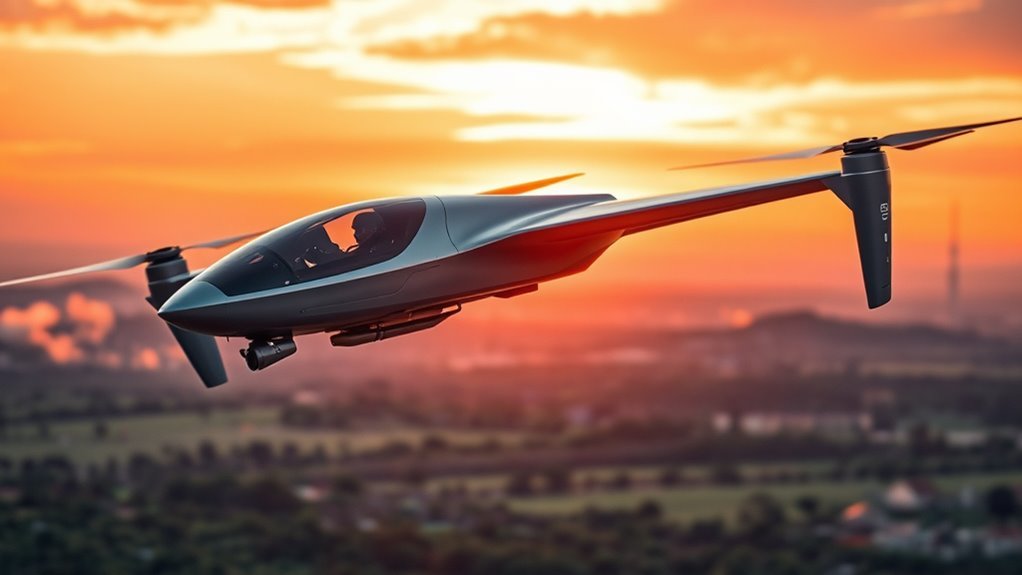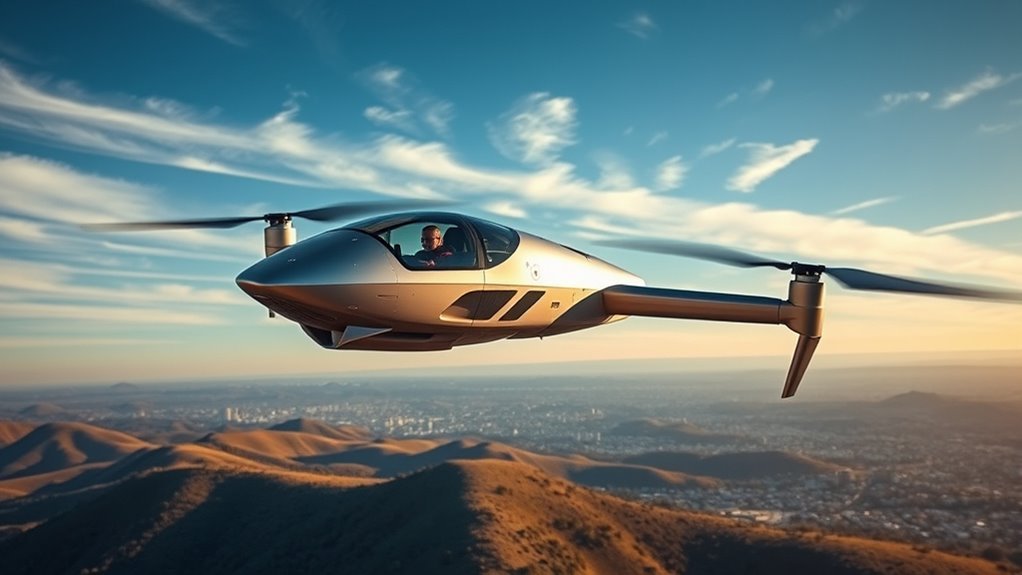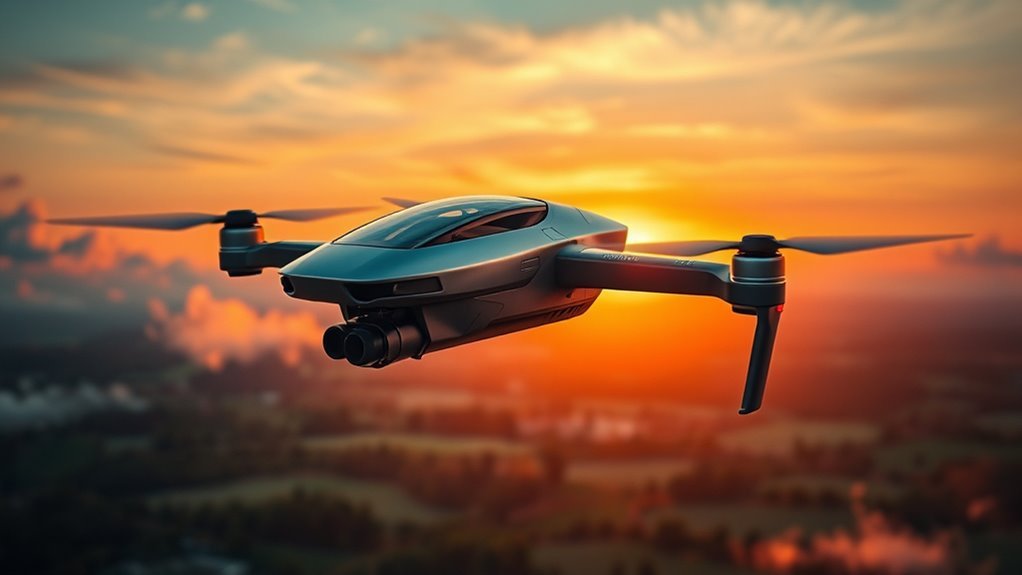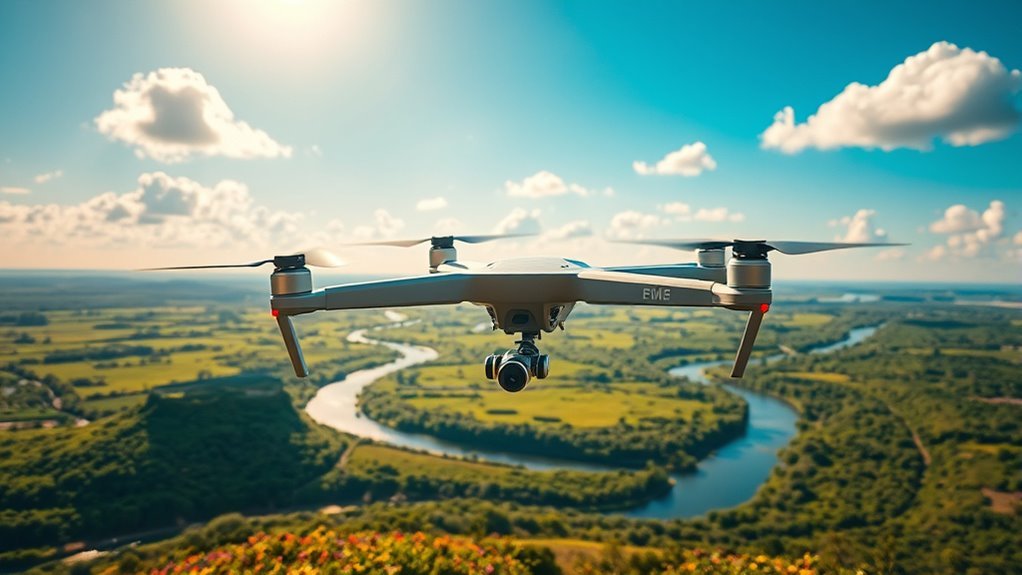Understanding manned drones is vital for grasping their role in modern aviation. They combine pilot expertise with advanced technology, enhancing operational efficiency across industries. Manned drones come in various types, including military, commercial, and recreational models. Key components, such as control systems and safety features, guarantee reliable performance and compliance with regulations. As you explore further, you’ll uncover their diverse applications, future prospects, and the challenges faced in this rapidly evolving field.
The Evolution of Manned Drones

As technology advanced, the concept of manned drones evolved from mere speculation to practical application, reshaping various industries. You can trace this evolution through significant historical milestones, like the development of the first crewed aircraft in the early 20th century, which laid the groundwork for future innovations. Technological breakthroughs, such as enhanced materials and autonomous navigation systems, have propelled the design and functionality of manned drones. These advancements not only improved safety and efficiency but also expanded their potential for applications ranging from transportation to surveillance. As you explore these developments, you’ll see how they’ve enabled a new era of freedom in aviation, allowing individuals to experience flight in ways previously unimaginable, while promoting innovative solutions across various sectors. Additionally, the incorporation of advanced stabilization algorithms has enhanced the reliability of manned drones, ensuring safer flights in challenging conditions.
Types of Manned Drones

When exploring the types of manned drones, you’ll encounter distinct categories tailored for specific applications. Military manned drones are engineered for tactical operations, while commercial variants focus on industry needs. Recreational manned drones, on the other hand, cater to hobbyists and enthusiasts.
Military Manned Drones
Although military manned drones often blend the capabilities of traditional aircraft with advanced unmanned technology, they can be categorized into several distinct types based on their roles and functionalities. You’ll find combat drones, designed for direct engagement in drone warfare, facilitating precision strikes while minimizing risks to personnel. Reconnaissance drones serve military applications by gathering essential intelligence without exposing crew members to danger. Additionally, support drones provide logistical assistance, enhancing operational efficiency. Each type plays an important role in modern warfare, ensuring that military forces maintain an advantage in both strategy and execution. Understanding these classifications allows you to appreciate the intricate balance between manned operations and technological advancements in military contexts.
Commercial Manned Drones
While military manned drones showcase advanced capabilities in warfare, commercial manned drones serve a different purpose, focusing on various industries and applications. These drones are increasingly finding their place in sectors like agriculture, logistics, and emergency services. As you explore commercial applications, you’ll notice trends highlighting the growing demand for aerial transportation, surveillance, and environmental monitoring. Market trends indicate a shift towards automation and enhanced safety features, allowing businesses to improve efficiency and reduce operational costs. Additionally, regulatory advancements are paving the way for broader acceptance and integration of these drones into everyday operations, presenting opportunities for innovation. Understanding these dynamics will empower you to grasp the transformative potential of commercial manned drones in the evolving landscape of technology.
Recreational Manned Drones
Recreational manned drones, often referred to as personal drones or hobbyist drones, represent an exciting frontier in aerial technology. These drones provide you with unique flying experiences and numerous recreational benefits. Whether you’re soaring over picturesque landscapes or engaging in aerial photography, the thrill is unparalleled.
- Enhanced personal freedom in the skies
- Opportunities for skill development in piloting
- Community engagement through drone clubs
- Versatile use for leisure activities and exploration
- Innovative technology encouraging creativity
As you navigate this burgeoning field, you’ll discover how recreational manned drones not only enhance your flying experiences but also foster a deeper connection to the world around you, allowing for both adventure and relaxation.
Key Components and Technology

Manned drones, often referred to as crewed unmanned aerial vehicles (UAVs), integrate several key components and advanced technologies to guarantee operational efficiency and safety. Central to these systems are control systems that ensure precise navigation and handling. These systems utilize advanced algorithms and sensors, providing real-time data to pilots for optimal performance. Additionally, propulsion technology plays a vital role, encompassing electric motors or combustion engines that deliver the necessary thrust while maintaining energy efficiency. Together, these components allow for enhanced maneuverability and responsiveness, essential for various applications ranging from recreational use to commercial transport. By understanding these technologies, you can appreciate the complexities that make manned drones a revolutionary tool for personal and professional freedom. Furthermore, real-time data processing ensures that weight management is optimized during flight, enhancing stability and operational reliability. Moreover, EHang’s advanced AI algorithms drive precision in navigation and obstacle detection, significantly improving the overall safety and efficiency of manned drone operations.
Safety Features and Regulations
When operating manned drones, understanding essential safety mechanisms is vital for ensuring operational integrity. You’ll also need to familiarize yourself with regulatory compliance standards that govern drone usage. These elements work together to mitigate risks and promote safe flight practices. Additionally, incorporating features like geo-fencing and altitude limits can enhance compliance with various safety regulations. Implementing robust safety features such as collision avoidance systems can significantly reduce the risk of accidents during flight.
Essential Safety Mechanisms
As technology advances, ensuring the safety of manned drones becomes crucial, particularly given their potential to operate in populated areas. You’ll want to be aware of key safety mechanisms that safeguard passengers and the public alike. These include:
- Redundant Systems: Backup systems for critical flight functions.
- Emergency Protocols: Clearly defined procedures for unexpected situations.
- Pilot Training: Thorough training programs ensuring pilot proficiency and preparedness.
- Automatic Safety Features: Systems like collision avoidance and altitude control.
- Real-time Monitoring: Continuous tracking of drone performance and environmental conditions.
Understanding these mechanisms is essential for maximizing safety and ensuring that manned drones can operate freely while minimizing risks. Embracing these features will empower you to navigate the skies with confidence.
Regulatory Compliance Standards
Ensuring regulatory compliance is essential for the safe operation of manned drones, particularly as they begin to integrate into existing airspace systems. You’ll encounter various regulatory frameworks that govern their use, and traversing these can present compliance challenges. Understanding these standards helps mitigate risks and enhances safety.
| Regulatory Framework | Key Aspects |
|---|---|
| FAA Regulations | Airworthiness, licensing |
| ICAO Guidelines | International standards |
| Local Laws | Community restrictions |
| Privacy Regulations | Data protection |
| Environmental Standards | Noise and emissions |
Applications in Various Industries
While the integration of manned drones into various industries is still evolving, their potential applications are already demonstrating significant advancements. You’ll find these drones enhancing operations across multiple sectors, showcasing their versatility and efficiency.
- Agricultural applications: Drones optimize crop monitoring and precision farming. This includes leveraging AI integration for smarter farming to enhance decision-making processes.
- Medical transport: They enable rapid delivery of medical supplies in critical situations.
- Disaster response: Drones assess damage and deliver aid to affected areas quickly.
- Aerial surveying: They facilitate detailed mapping and analysis of landscapes.
- Infrastructure inspection: Drones provide safe, efficient evaluations of structures like bridges and towers.
In agriculture, the use of drones for advanced monitoring can predict crop threats and optimize interventions, further enhancing their impact. With capabilities that extend into tourism enhancement, search operations, and wildlife monitoring, manned drones are set to redefine boundaries and improve operational freedom across these essential industries.
Manned Drones vs. Traditional Aircraft
When comparing manned drones to traditional aircraft, you’ll notice significant differences in operational flexibility and cost efficiency. Manned drones often offer the ability to adapt quickly to various missions, which can enhance effectiveness in dynamic environments. Additionally, analyzing the cost structures reveals potential savings with manned drones, particularly in maintenance and operational expenditures.
Operational Flexibility Comparison
Although traditional aircraft have long been the backbone of aerial operations, manned drones are rapidly redefining the landscape of operational flexibility. Their unique design enhances operational capabilities and mission adaptability, giving you options that weren’t previously possible. Here are some key advantages:
- Enhanced maneuverability in confined spaces
- Ability to operate in diverse environments and conditions
- Reduced turnaround times for mission redeployment
- Streamlined integration with advanced technology systems
- Greater mission customization based on real-time data
These factors mean you can respond swiftly to changing situations, maximizing your operational effectiveness. As you explore the possibilities, it’s clear that manned drones offer a level of flexibility that traditional aircraft struggle to achieve, ultimately expanding your tactical advantages in the field.
Cost Efficiency Analysis
As you evaluate the financial implications of incorporating manned drones into your operations, it’s essential to take into account their cost efficiency compared to traditional aircraft. A thorough cost analysis reveals that manned drones often incur lower acquisition and maintenance costs, translating into significant operational savings over time. Their streamlined design and reduced fuel consumption further enhance this efficiency, allowing you to allocate resources more effectively. Additionally, the versatility of manned drones means you can adapt them for various missions without the hefty price tag associated with conventional aircraft. Ultimately, investing in manned drones not only provides operational flexibility but also positions you for long-term financial sustainability in an ever-evolving aerospace landscape.
The Future of Manned Drones
While the concept of manned drones may still seem futuristic, advancements in technology and regulatory frameworks are rapidly shaping their potential integration into various sectors. You might see future advancements in areas like:
- Autonomous flight systems enhancing safety
- Hybrid propulsion technologies improving efficiency
- Advanced navigation systems for urban environments
- Real-time data analytics for operational optimization, including proactive vulnerability identification that ensures secure operations.
- Regulatory frameworks evolving to accommodate new uses
As these innovations unfold, the possibility of using manned drones for medical emergencies, logistics, and transportation becomes more tangible. Furthermore, developments in AI-enhanced flight capabilities are set to revolutionize how these drones navigate complex environments. However, you should remain aware of the potential challenges that could arise, such as public acceptance and airspace management. Staying informed about these developments will empower you to embrace the future of manned drones effectively.
Challenges Facing Manned Drones
Despite the promising potential of manned drones, several challenges could impede their widespread adoption. You’ll face design limitations that restrict performance and payload capabilities. Public perception often leans toward skepticism, amplifying safety concerns and operational risks associated with manned operations. Regulatory hurdles complicate the integration into existing airspace, while technological advancements must keep pace with market competition. Finally, infrastructure challenges, like charging stations or landing zones, are critical for effective deployment.
| Challenge | Description |
|---|---|
| Design Limitations | Constraints in performance and payloads |
| Public Perception | Skepticism affecting acceptance |
| Regulatory Hurdles | Complex regulations for airspace integration |
| Technological Advances | Need for ongoing innovation |
| Infrastructure Issues | Lack of necessary support facilities |
Environmental Impact and Sustainability
The environmental impact and sustainability of manned drones are essential factors as the technology matures. You’ll want to focus on how these innovations can align with ecological goals, especially in the context of sustainable materials and emissions reduction. Here are key points to reflect on:
As manned drones evolve, prioritizing their environmental impact and sustainability is crucial for future innovations.
- Use of lightweight, sustainable materials to minimize resource depletion.
- Adoption of electric propulsion systems to lower carbon emissions.
- Implementation of energy-efficient flight paths to reduce fuel consumption.
- Development of recycling programs for drone components post-use.
- Regular assessment of environmental impact to verify compliance with regulations.
Getting Started With Manned Drones
As you begin your journey into the domain of manned drones, understanding the foundational aspects of this technology is essential. Manned drone training typically involves both theoretical knowledge and practical experience. Utilizing flight simulation tools can greatly enhance your learning curve, allowing you to practice in a risk-free environment.
| Training Aspect | Description | Benefits |
|---|---|---|
| Theory | Understanding aerodynamics and regulations | Knowledge base for safe operations |
| Flight Simulation | Virtual environment for piloting practice | Risk-free skill enhancement |
| Practical Training | Hands-on experience with actual drones | Real-world operational skills |
| Certification | Formal recognition of competence | Legitimacy in the industry |
Frequently Asked Questions
What Are the Costs Associated With Purchasing a Manned Drone?
Don’t let high manned drone pricing discourage you. While initial costs can be significant, consider ongoing operating expenses, including maintenance and fuel, which can impact your overall budget and freedom to operate effectively.
How Do Manned Drones Affect Job Opportunities in Aviation?
Manned drones can lead to job displacement in traditional aviation roles, yet they also drive industry transformation, creating new opportunities in drone maintenance, operations, and management. Embracing these changes can enhance your career potential in aviation.
What Training Is Required to Operate a Manned Drone?
To operate a manned drone, you’ll need pilot certification and thorough training in safety protocols. Mastering these elements guarantees you’re prepared for the responsibilities of flying and maintaining the aircraft safely and effectively.
Can Manned Drones Be Used for Personal Transportation?
Yes, manned drones can be used for personal transportation, but you’ll need to navigate personal drone regulations. Urban air mobility is evolving, offering potential freedom, yet safety and regulatory compliance remain critical for successful integration.
What Are the Insurance Requirements for Manned Drone Operators?
Maneuvering the skies requires caution. As a manned drone operator, you’ll need adequate liability coverage, typically with policy limits that reflect potential risks. Understanding these requirements guarantees you’re prepared for any unforeseen circumstances that might arise.

